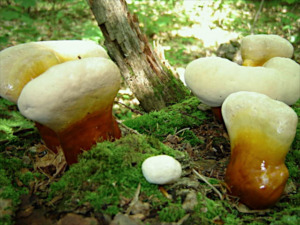
Ganoderma lucidum may lower glucose levels in diabetics.
A growing body of evidence suggests that ganoderma (reishi mushroom), an herb used in traditional Chinese medicine, may assist the sufferers of type II diabetes. However, much of this less than rock-solid evidence is based on research from non-Western universities, and the countless anecdotes relayed by believers.
Much of the research linking ganoderma to lower blood sugar levels in patients with diabetes mellitus was conducted at universities in China, and its territories Taiwan and Hong Kong. Western research on the subject is scant. There, ganoderma is considered a homeopathic treatment, not a true medicine.
The dearth of Western research is also likely due to the lack of potential money making opportunities from any links found between diabetes and ganoderma. Ganoderma is a mushroom, after all. It is difficult, if not impossible, to patent a medicine based on an herb. That is primarily why pharmaceutical companies have no interest in researching ganoderma or any other homeopathic remedies to chronic disease.
How does ganoderma benefit diabetes?
The current research, conducted on both humans and mice, suggests that ganoderma can lower blood glucose levels of diabetes sufferers in as little as one week. The average time frame is between one and twelve weeks before meaningful improvement in blood sugar levels could be measured. Higher dosages of ganoderma produced faster and more dramatic results.
The specific mechanisms for this effect are not entirely known at this time. But it is believed that certain polysaccharides in ganoderma inhibit the production of an enzyme by the liver used to produce glucose. Additionally, proteins and triterpenoids in ganoderma have been reported to have hypoglycemic effects. A protein called tyrosine phosphatase 1B is a promising therapeutic target in diabetes, and ganoderma can inhibit this enzyme.
Other studies indicate that polysaccharides in ganoderma lucidum reduce and delay the absorption of glucose in rats . The possible mechanism for this anti-hyperglycemic effect is still unknown. But it is suspected that these polysaccharides increase the renewal of beta cells in the pancreas, which stimulates pancreatic insulin secretion.
It’s important to note that ganoderma is only recommended for treatment of diabetes mellitus, and not type I diabetes. The effects of ganoderma on blood sugar levels are generally not strong enough to assist in type I diabetes and, additionally, the herb may contraindicate insulin injection.
How to obtain and take ganoderma lucidum for the treatment of diabetes
Reishi mushroom has a tough, bark-like flesh that is is not edible in its natural form. Therefore, unlike most other medicinal herbs, it’s necessary to process ganoderma before it is consumed. Ganoderma extract is popular, as is ganoderma infused coffee and tea. See the links below for some interesting ideas on how to incorporate ganoderma into your diet.ganoderma
As for recommended dosage, respect the individual product label. Not all diabetics respond to ganoderma in the same way. Some have side effects, and some don’t. Some see better results than others. So be sure to check your blood sugar level regularly, and adjust your ganoderma consumption as appropriate.
Finding ganoderma in stores in United States and other Western countries can be tricky. As discussed, reishi mushroom is commonly found in Asian countries, but is more difficult to find here. If you live in a country that Amazon.com services, ganoderma is easy to buy online, however. See the links just below for some ideas on how to incorporate ganoderma into your diet.
And please let us know in the comments if you have experience with treating diabetes with ganoderma lucidum. Have you found it helpful? Would you recommend ganoderma to other diabetics?
Buy Ganoderma Coffee and Tea
 |  |  |
| Ganoderma Coffee | Ganocafe Classic | Gano Cafe 3-in-1 |


Leave a Reply